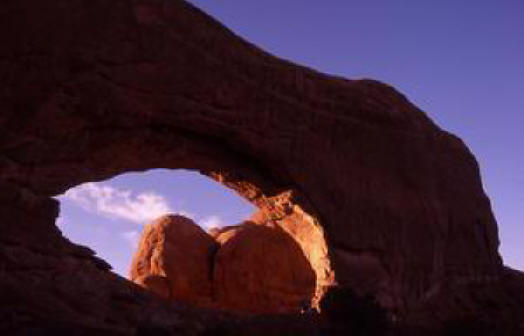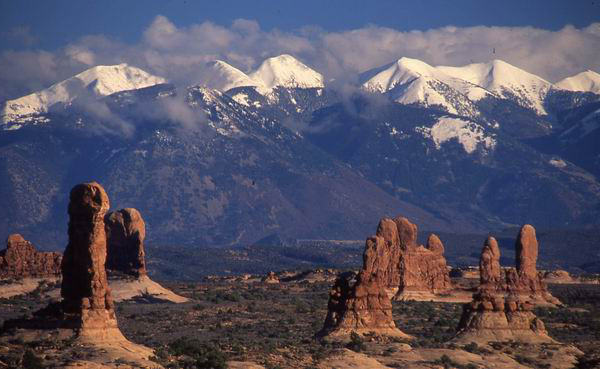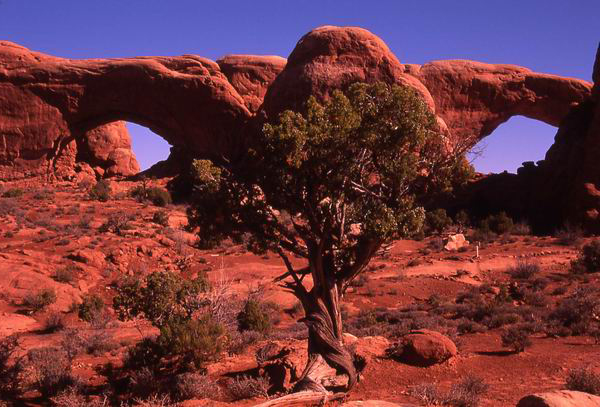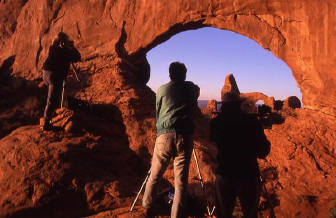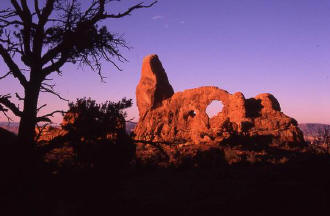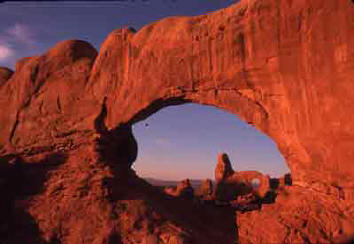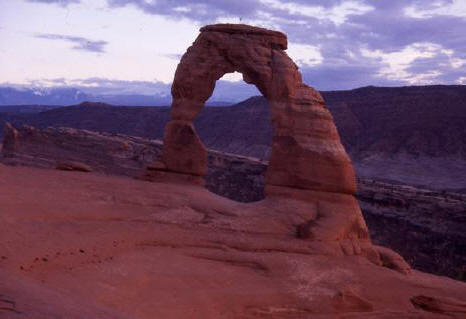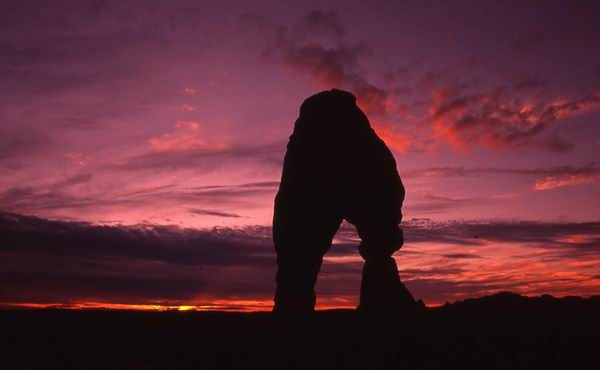|
ARCHES NATIONAL PARK A Look Through the Windows of Time by James H. Moerschel
As I drive through the arid sections of Arches National Park, it is hard to imagine that long ago, an ancient sea covered this area. It deposited an immense salt bed, thousands of feet thick and over millions of years has shifted, buckled and liquefied – thrusting huge rock formations upward. Most of the formations and arches are of Entrada sandstone and the relentless forces of erosion continue to change their bizarre shapes. For the traveling photographer, this place is a "must see." This park has more than 2000 cataloged arches making it the area with the most concentration of these beautiful structures.
During November, the distant, but highly visible La Sal Mountains form a beautiful backdrop for photos of the many rock formations and some of the arches. At this time of year there is a good chance for snow on the peaks that contrasts strongly with the red rock creating beautiful scenic landscapes.
Early morning and late afternoon yields the best light for photography and the photographer should be in position well before the light rises or sets. For when it does it moves swiftly and those precious, magical moments of low angled "sweet light" become an overpowering glare. There is a very popular photograph of Turret Arch viewed through another arch called The North Window and I was determined to make this shot. I made my way through the dark toward North Window and stepped through it. I wasn’t alone. Standing on a narrow ledge about sixty feet away and facing me were four photographers with camera mounted tripods waiting for the first rays of daylight. The narrow ledge trail wraps around the walls of the formation leading to the favored spot for the shot and extreme care must be taken, for one isplaced foot can send the photographer and his gear thirty feet into a chasm. Professional photographers, Mihalis and Sarah Vourtsis, graciously moved over, provided me with the last remaing spot on the now crowded ledge and we all waited in tense silence for the light show to begin. First there was a weak glow on the North Window for a few moments, then suddenly there was an explosion of light, beaming brilliantly on the huge arch before us. Turret Arch in the distance was also bathed by the golden sunrise. This shot is a wide-angle image and I was using a 24mm lens. I was wishing that I had a 20mm to include more of the immense rock face before me, but that will have to wait for my next trip here. Everyone made several images and then traversed the narrow ledge back through the North Window and onto the hiking trail.
When photographing these highly reflective sandstone formations, metering the scene can be tricky. The tonality of the stone is very bright and it is necessary to take a meter reading from something that is medium toned and being lit in the same way as the subject. This will prevent severely underexposing the photograph. In this region there is not an abundance of medium toned grass, trees or gray rocks, so the blue sky becomes a handy source of a medium toned reference. I used this method throughout my stay here and also bracketed each scene in one-third increments. Once the sun rose higher, I still continued to shoot landscapes. The polarizing filter is a good choice in creating mid-day scenics, by darkening the blue sky , "popping" those white clouds and removing any reflections from the sandstone. There is an area called "fiery furnace" and I positioned myself nearby just before sunset. When the sun set it cast a beam of glowing light upon the deep red sandstone cliffs. The color of the red cliff kept intensifying as the sun continued its decent and it became very apparent how it got its name.
In this park I used my wide angle zoom (24 – 70) often, and particularly when I had to be close to the arch or actually beneath them. This gave me some unusual angles and added visual spice to the images. My 100 – 300 zoom was also used to gain accessibility to subjects in hard to reach places. On some photos I used the telephoto to compress the distant La Sal Mountains as the background for the unusual and bizarre foreground subjects. There are some small herds of mule deer that can be easily approached and a long telephoto will allow you to fill the frame. A visit to Arches is not complete without hiking to Delicate Arch and of course this is the choice spot to photograph the "symbol" of the park. Allow yourself plenty of time for a casual walk up the one and a half mile ascending trail to the arch. Most likely you will not be alone here as this is a very popular spot to take photos or to just sit and watch the sun set. So if you arrive early, choose your angle, take a spot and wait for the setting sun to work its magic. My primary choice of composition is shown in my first photo of Delicate Arch. This would have included the snow capped La Sal mountains as a distant background as the setting sun would strike its low angled rays onto the subject. However, the cloud formations in the west didn’t cooperate, and they completely blocked the setting sun at the critical moment.
The result was a drab, ordinary image of what can be a most stunning scene when the "sweet light" hits. But all was not lost. Finally, a sliver of light began to pierce the clouds. I quickly changed position, set the tripod so I had the sun
in the frame and the arch would be a silhouette against the glowing sky. Volia! And don’t forget to bring a flashlight so you can find your way down the trail in the dark.
I wish you good
luck in your image making and may all your visions be photogenic."
|
